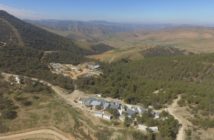Toubkal <%E2%80%99s”>http://en.wikipedia.org/wiki/Toubkal>’s name translates to “big” in Arabic, and at 4,167 meters (13,671 feet), it’s the highest peak in the Atlas Mountains and Northern Africa in general.
Since the mountain is 70 kilometers from Marrakech, my brother and I took a scenic van ride that led us to the base of the mountain in the town of Imlil <http://en.wikipedia.org/wiki/Imlil>. Imlil is the typical place to connect with guides for the ascent of the mountain.
In Imlil, my brother and I hooked up with MTM Travel Agency
<http://www.mountain-travel-morocco.com/>. They provided us with a guide, Abdul, a porter (who also served as cook), and a few mules to carry supplies. I would recommend using this outfit for the trek; they were very hospitable and professional.

We spent the rest of the first day hiking to the Refuge du Toubkal, a mountain shelter built out of stone. We passed the village of Aroumd and stopped to have tea and biscuits in Abdul’s home.
After Aroumd, we followed a path down the left slope of the valley to the south. The valley curved towards Sidi Chamharouch, which centered around a Muslim shrine. At Sidi Chamharouch, the path ran over a frozen stream and moved steeply uphill to the east side of the Isougouane Valley, which led us to the cabin, where we slept in all of our clothes inside our sleeping bags.
The next day was more treacherous and exhausting, since we had to reach the summit and come back down before the end of the day. Even with the physical exertion, we used all of our layers. We were equipped with crampons for our boots and ice picks in case of an emergency.
Traversing in a zig-zag pattern, we stomped the crampons into the ice with every step to maintain balance. When the sun lifted over the peak in the afternoon, we wore sunglasses or ski goggles to protect our eyes from the reflection on the snow – which, according to Abdul, could be blinding.
When we reached the top, my feeling of accomplishment was coupled by numbness in my feet, so I paced around to keep warm until we headed back down. As I basked in the panoramic view of the mountain range, I watched my breath disappear into the vapor of the clouds.
When we got back down to the refuge, we were greeted with piping hot tajine, a traditional Moroccan dish named after the cooking pot from which it is served. Tajine combines lamb or chicken with a plethora of ingredients like olives, apples, pears, prunes, dates and nuts.
The next day consisted of retracing our steps back to the villages at the base of the mountain, totaling a three-and-a-half day trip.
If you’re ever in southwestern Morocco and enjoy the outdoors, this is the trip to do. But if you are not an experienced hiker, make sure to hire a guide, and be prepared for a wide range of temperatures.
Envoyé de mon iPhone






